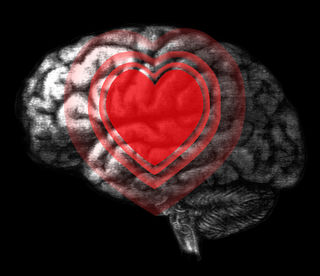Relationships
Love in the Brain
How love can change and be changed by your brain.
Posted December 3, 2019 Reviewed by Gary Drevitch
Barry was a grumpy and ungrateful husband. His wife, Sue, tried to remember the last time he had made eye contact with her, let alone when they had last laughed together. It wasn’t what she had imagined their life would be like when they had first met. She was tired of the same old routine—of trying to engage her husband in conversation while he grunted replies. She wasn’t sure how much longer she could stand it. In an instant, that would all change.
Late one night, Sue woke to find Barry crying out in pain and clutching his head. He had suffered a stroke—to be precise, a subarachnoid haemorrhage due to a ruptured left posterior communicating artery aneurysm. Brain scans showed damage to the left hemisphere of his brain, in particular, his left temporal lobe and basal ganglia, which had been scarred by blood and starved of oxygen.
I met Barry and Sue three months later, when he was referred for a neuropsychological assessment. Barry said he did not have any complaints except for some occasional word-finding difficulties. He smiled and told me he felt great. "Better than ever," he said. "It’s weird!" When I asked if I could speak with Sue alone, he kissed her on the hand and said, "See you soon, my love." She laughed and looked shyly at me.
Sue revealed the colossal shift in their relationship. "It’s marvelous how this has changed him," she told me. "He’s done a 180! He’s happy all the time, enjoying life, laughing more. He loves everything now. He’s different—it’s a new version of the old Barry. He’s always saying how much he loves me, and 'You’re beautiful.' It’s wonderfully overwhelming." Barry had unexpectedly transformed into the romantic husband she’d always hoped for, a man brimming with joy and constantly professing his love for his wife. His burst brain aneurysm had saved their marriage.
It is rare for anyone affected directly or indirectly by a brain injury to consider it a positive thing, but if it resulted in enhanced love, and a more lovable version of the person you knew before, who wouldn’t consider it a blessing? Barry’s case raises obvious questions: Are there certain brain regions that are crucial for love? Were these regions somehow "released" by Barry’s stroke?

Brain imaging can only reflect a snapshot of time, and cannot possibly capture the complex experience of love, but it can provide some intriguing insights into the brain regions that are involved in love. Using functional MRI brain scanning techniques (fMRI), which measure blood flow or glucose metabolism (how the blood in our brain uses energy), researchers have examined the brains of people in love while they look at pictures of their romantic partner. They have identified that the brain networks related to romantic love overlap with parts of the brain involved in our neural "reward system."
Brain scans of people in love have revealed activation (or increased blood flow) to parts of the frontal lobe (such as the anterior cingulate cortex), basal ganglia (nucleus accumbens and caudate nucleus) and hypothalamus—brain regions that process reward. Amazingly, different patterns of activation and functional connectivity between brain regions have been found when comparing people in and out of love, and those who have never been in love. Even when the brain is "at rest" or "in neutral"—that is, not engaged in a particular task (such as staring at a photo of a lover)—there are differences in the brains of people who are in or out of love.
A part of the frontal lobe (specifically, the left dorsal anterior cingulate cortex) shows differences in ‘regional homogeneity’, or synchronised neural activity, depending on whether you are in or out of love, and how long it has been since you experienced love.
People who are "in love" have increased left dorsal anterior cingulate regional homogeneity or neural activity that is more "in synch." Surprisingly, this is positively associated with the length of time they have been in love, so it is greater in those who have been in love for a longer period of time than for those experiencing the first flush of new love. On the other hand, for those out of love, the longer it has been since a break-up, the less regional homogeneity will be found in the left dorsal anterior cingulate cortex.
Furthermore, when people are in love, their brains display increased functional connectivity—that is, an increase in spontaneous blood-oxygen-dependent signals between spatially remote regions and networks of the brain. When we are in love, this functional connectivity increases between the regions that are involved in reward, motivation, and emotion regulation (such as the amygdala), and in social cognition, or the types of thinking skills required to negotiate social relationships (such as the medial prefrontal cortex and temporal lobe). So, in a chicken-and-egg kind of way, it seems that love enhances the patterns of activation within brain regions that control the very functions that you need to feel love,
In Barry's case, the positive outcome of his stroke could be due to it affecting the left side of his brain, leading to an improvement in his expression and experience of all positive emotions, not just love.
In a study of people with frontotemporal dementia, those with greater left frontal atrophy were found to show increased expressions of happiness in response to a film. Selective damage to left frontal brain regions may weaken positive emotion regulation and correspondingly facilitate positive emotional responses—or expressions of happiness. This extends earlier research that suggested the left frontal lobe is involved in generating positive emotion, and indicates that damage to this area may actually enable positive emotions to be expressed.
After months of rehabilitation, Barry returned to work. When he comes home each evening, the first thing he does is kiss Sue, ask how her day was, and tell her that dinner smells delicious. Grumpy pre-stroke Barry is long gone, and Sue is thankful for the change that gave her a loving husband. Barry's is a rare example of a brain injury having a positive outcome, resulting in him being a much more pleasant and loving guy, and enabling a happier relationship, to his wife’s relief.
This is an adapted excerpt from Sex in the Brain: How Your Brain Controls Your Sex Life (NewSouth Publishing, 2019; and forthcoming Columbia University Press, 2020)
Facebook image: Iakov Filimonov/Shutterstock
References
Song, H., Zou, Z., Kou, J., Liu, Y., Yang, L., Zilverstand, A., ... Zhang, X. (2015). Love-related changes in the brain: A resting-state functional magnetic resonance imaging study. Frontiers in Human Neuroscience, 9, 71.
Sturm, V.E., Yokoyama, J.S., Eckart, J.A., Zakrzewski, J., Rosen, H.J., Miller, B.L., … Levenson, R.W. (2015). Damage to left frontal regulatory circuits produces greater emotional reactivity in frontotemporal dementia. Cortex, 64, 55–67.




